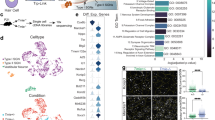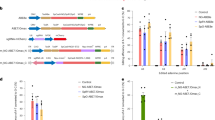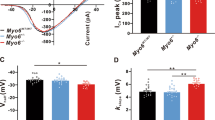Abstract
Deafness or hearing loss is a major issue in human health. Inner ear hair cells are the main sensory receptors responsible for hearing. Defects in hair cells are one of the major causes of deafness. A combination of induced pluripotent stem cell (iPSC) technology with genome-editing technology may provide an attractive cell-based strategy to regenerate hair cells and treat hereditary deafness in humans. Here, we report the generation of iPSCs from members of a Chinese family carrying MYO15A c.4642G>A and c.8374G>A mutations and the induction of hair cell-like cells from those iPSCs. The compound heterozygous MYO15A mutations resulted in abnormal morphology and dysfunction of the derived hair cell-like cells. We used a CRISPR/Cas9 approach to genetically correct the MYO15A mutation in the iPSCs and rescued the morphology and function of the derived hair cell-like cells. Our data demonstrate the feasibility of generating inner ear hair cells from human iPSCs and the functional rescue of gene mutation-based deafness by using genetic correction.
Similar content being viewed by others
Log in or create a free account to read this content
Gain free access to this article, as well as selected content from this journal and more on nature.com
or
Abbreviations
- iPSC:
-
induced pluripotent stem cell
- ESC:
-
embryonic stem cell
- CRISPR:
-
clustered regularly interspaced short palindromic repeat
- Cas9:
-
CRISPR-associated protein 9
- HDR:
-
homology directed repair
- CUSC:
-
chicken utricle stromal cell
- AP:
-
alkaline phosphatase
- ssODN:
-
single-strand oligonucleotide
- GFP:
-
green fluorescent protein
- FACS:
-
fluorescence-activated cell sorting
- WT:
-
wild type
References
Lentz JJ, Jodelka FM, Hinrich AJ, McCaffrey KE, Farris HE, Spalitta MJ et al. Rescue of hearing and vestibular function by antisense oligonucleotides in a mouse model of human deafness. Nat Med 2013; 19: 345–350.
Muller U, Barr-Gillespie PG . New treatment options for hearing loss. Nat Rev Drug Discov 2015; 14: 346–365.
Brownstein Z, Abu-Rayyan A, Karfunkel-Doron D, Sirigu S, Davidov B, Shohat M et al. Novel myosin mutations for hereditary hearing loss revealed by targeted genomic capture and massively parallel sequencing. Eur J Hum Genet 2014; 22: 768–775.
Kochhar A, Hildebrand MS, Smith RJ . Clinical aspects of hereditary hearing loss. Genet Med 2007; 9: 393–408.
Nadol JB Jr . Hearing loss. N Engl J Med 1993; 329: 1092–1102.
Oshima K, Shin K, Diensthuber M, Peng AW, Ricci AJ, Heller S . Mechanosensitive hair cell-like cells from embryonic and induced pluripotent stem cells. Cell 2010; 141: 704–716.
Koehler KR, Mikosz AM, Molosh AI, Patel D, Hashino E . Generation of inner ear sensory epithelia from pluripotent stem cells in 3D culture. Nature 2013; 500: 217–221.
Chen W, Jongkamonwiwat N, Abbas L, Eshtan SJ, Johnson SL, Kuhn S et al. Restoration of auditory evoked responses by human ES-cell-derived otic progenitors. Nature 2012; 490: 278–282.
Watada Y, Yamashita D, Toyoda M, Tsuchiya K, Hida N, Tanimoto A et al. Magnetic resonance monitoring of superparamagnetic iron oxide SPIO)-labeled stem cells transplanted into the inner ear. Neurosci Res 2015; 95: 21–26.
Okano T, Kelley MW . Stem cell therapy for the inner ear: recent advances and future directions. Trends Amplif 2012; 16: 4–18.
Zhang PZ, He Y, Jiang XW, Chen FQ, Chen Y, Xue T et al. Up-regulation of stromal cell-derived factor-1 enhances migration of transplanted neural stem cells to injury region following degeneration of spiral ganglion neurons in the adult rat inner ear. Neurosci Lett 2013; 534: 101–106.
Tateya I, Nakagawa T, Iguchi F, Kim TS, Endo T, Yamada S et al. Fate of neural stem cells grafted into injured inner ears of mice. Neuroreport 2003; 14: 1677–1681.
Doyle KL, Kazda A, Hort Y, McKay SM, Oleskevich S . Differentiation of adult mouse olfactory precursor cells into hair cells in vitro. Stem Cells 2007; 25: 621–627.
Hudspeth AJ . Integrating the active process of hair cells with cochlear function. Nat Rev Neurosci 2014; 15: 600–614.
Scheffer DI, Zhang DS, Shen J, Indzhykulian A, Karavitaki KD, Xu YJ et al. XIRP2, an actin-binding protein essential for inner ear hair-cell stereocilia. Cell Rep 2015; 10: 1811–1818.
Manor U, Disanza A, Grati M, Andrade L, Lin H, Di Fiore PP et al. Regulation of stereocilia length by myosin XVa and whirlin depends on the actin-regulatory protein Eps8. Curr Biol 2011; 21: 167–172.
Karolyi IJ, Probst FJ, Beyer L, Odeh H, Dootz G, Cha KB et al. Myo15 function is distinct from Myo6, Myo7a and pirouette genes in development of cochlear stereocilia. Hum Mol Genet 2003; 12: 2797–2805.
Belyantseva IA, Boger ET, Friedman TB . Myosin XVa localizes to the tips of inner ear sensory cell stereocilia and is essential for staircase formation of the hair bundle. Proc Natl Acad Sci USA 2003; 100: 13958–13963.
Delprat B, Michel V, Goodyear R, Yamasaki Y, Michalski N, El-Amraoui A et al. Myosin XVa and whirlin, two deafness gene products required for hair bundle growth, are located at the stereocilia tips and interact directly. Hum Mol Genet 2005; 14: 401–410.
Woo HM, Park HJ, Baek JI, Park MH, Kim UK, Sagong B et al. Whole-exome sequencing identifies MYO15A mutations as a cause of autosomal recessive nonsyndromic hearing loss in Korean families. BMC Med Genet 2013; 14: 72.
Gao X, Zhu QY, Song YS, Wang GJ, Yuan YY, Xin F et al. Novel compound heterozygous mutations in the MYO15A gene in autosomal recessive hearing loss identified by whole-exome sequencing. J Transl Med 2013; 11: 284.
Fattahi Z, Shearer AE, Babanejad M, Bazazzadegan N, Almadani SN, Nikzat N et al. Screening for MYO15A gene mutations in autosomal recessive nonsyndromic, GJB2 negative Iranian deaf population. Am J Med Genet A 2012; 158A: 1857–1864.
Chang MY, Kim AR, Kim NK, Lee C, Lee KY, Jeon WS et al. Identification and clinical implications of novel MYO15A mutations in a non-consanguineous Korean family by targeted exome sequencing. Mol Cells 2015; 38: 781–788.
Miyagawa M, Nishio SY, Hattori M, Moteki H, Kobayashi Y, Sato H et al. Mutations in the MYO15A gene are a significant cause of nonsyndromic hearing loss: massively parallel DNA sequencing-based analysis. Ann Otol Rhinol Laryngol 2015; 124 Suppl 1: 158S–168S.
Xia H, Huang X, Guo Y, Hu P, He G, Deng X et al. Identification of a novel MYO15A mutation in a Chinese family with autosomal recessive nonsyndromic hearing loss. PLoS One 2015; 10: e0136306.
Liburd N, Ghosh M, Riazuddin S, Naz S, Khan S, Ahmed Z et al. Novel mutations of MYO15A associated with profound deafness in consanguineous families and moderately severe hearing loss in a patient with Smith-Magenis syndrome. Hum Genet 2001; 109: 535–541.
Kalay E, Uzumcu A, Krieger E, Caylan R, Uyguner O, Ulubil-Emiroglu M et al. MYO15A (DFNB3) mutations in Turkish hearing loss families and functional modeling of a novel motor domain mutation. Am J Med Genet A 2007; 143A: 2382–2389.
Takahashi K, Yamanaka S . Induction of pluripotent stem cells from mouse embryonic and adult fibroblast cultures by defined factors. Cell 2006; 126: 663–676.
Martins AM, Vunjak-Novakovic G, Reis RL . The current status of iPS cells in cardiac research and their potential for tissue engineering and regenerative medicine. Stem Cell Rev 2014; 10: 177–190.
Revilla A, Gonzalez C, Iriondo A, Fernandez B, Prieto C, Marin C et al. Current advances in the generation of human iPS cells: implications in cell-based regenerative medicine. J Tissue Eng Regen Med 2015 (e-pub ahead of print 11 March 2015; doi:10.1002/term.2021).
Okano H . Stem cell research and regenerative medicine in 2014: first year of regenerative medicine in Japan. Stem Cells Dev 2014; 23: 2127–2128.
Ran FA, Hsu PD, Wright J, Agarwala V, Scott DA, Zhang F . Genome engineering using the CRISPR-Cas9 system. Nat Protoc 2013; 8: 2281–2308.
Izumikawa M, Minoda R, Kawamoto K, Abrashkin KA, Swiderski DL, Dolan DF et al. Auditory hair cell replacement and hearing improvement by Atoh1 gene therapy in deaf mammals. Nat Med 2005; 11: 271–276.
Zheng JL, Gao WQ . Overexpression of Math1 induces robust production of extra hair cells in postnatal rat inner ears. Nat Neurosci 2000; 3: 580–586.
Weiss S, Gottfried I, Mayrose I, Khare SL, Xiang M, Dawson SJ et al. The DFNA15 deafness mutation affects POU4F3 protein stability, localization, and transcriptional activity. Mol Cell Biol 2003; 23: 7957–7964.
Donaudy F, Zheng L, Ficarella R, Ballana E, Carella M, Melchionda S et al. Espin gene (ESPN) mutations associated with autosomal dominant hearing loss cause defects in microvillar elongation or organisation. J Med Genet 2006; 43: 157–161.
Kurima K, Ebrahim S, Pan B, Sedlacek M, Sengupta P, Millis BA et al. TMC1 and TMC2 localize at the site of mechanotransduction in mammalian inner ear hair cell stereocilia. Cell Rep 2015; 12: 1606–1617.
Pan B, Geleoc GS, Asai Y, Horwitz GC, Kurima K, Ishikawa K et al. TMC1 and TMC2 are components of the mechanotransduction channel in hair cells of the mammalian inner ear. Neuron 2013; 79: 504–515.
Kawashima Y, Geleoc GS, Kurima K, Labay V, Lelli A, Asai Y et al. Mechanotransduction in mouse inner ear hair cells requires transmembrane channel-like genes. J Clin Invest 2011; 121: 4796–4809.
Kawashima Y, Kurima K, Pan B, Griffith AJ, Holt JR . Transmembrane channel-like (TMC) genes are required for auditory and vestibular mechanosensation. Pflugers Arch 2015; 467: 85–94.
Xiong W, Grillet N, Elledge HM, Wagner TF, Zhao B, Johnson KR et al. TMHS is an integral component of the mechanotransduction machinery of cochlear hair cells. Cell 2012; 151: 1283–1295.
Zhao B, Wu Z, Grillet N, Yan L, Xiong W, Harkins-Perry S et al. TMIE is an essential component of the mechanotransduction machinery of cochlear hair cells. Neuron 2014; 84: 954–967.
Liedtke W . A precisely defined role for the tip link-associated protein TMIE in the mechanoelectrical transduction channel complex of inner ear hair cells. Neuron 2014; 84: 889–891.
Grskovic M, Javaherian A, Strulovici B, Daley GQ . Induced pluripotent stem cells—opportunities for disease modelling and drug discovery. Nat Rev Drug Discov 2011; 10: 915–929.
Shemer G, Podbilewicz B . Fusomorphogenesis: cell fusion in organ formation. Dev Dyn 2000; 218: 30–51.
Finger FP, White JG . Fusion and fission: membrane trafficking in animal cytokinesis. Cell 2002; 108: 727–730.
Probst FJ, Fridell RA, Raphael Y, Saunders TL, Wang A, Liang Y et al. Correction of deafness in shaker-2 mice by an unconventional myosin in a BAC transgene. Science 1998; 280: 1444–1447.
Tilney LG, Derosier DJ, Mulroy MJ . The organization of actin filaments in the stereocilia of cochlear hair cells. J Cell Biol 1980; 86: 244–259.
Mburu P, Mustapha M, Varela A, Weil D, El-Amraoui A, Holme RH et al. Defects in whirlin, a PDZ domain molecule involved in stereocilia elongation, cause deafness in the whirler mouse and families with DFNB31. Nat Genet 2003; 34: 421–428.
Kikkawa Y, Mburu P, Morse S, Kominami R, Townsend S, Brown SD . Mutant analysis reveals whirlin as a dynamic organizer in the growing hair cell stereocilium. Hum Mol Genet 2005; 14: 391–400.
Belyantseva IA, Boger ET, Naz S, Frolenkov GI, Sellers JR, Ahmed ZM et al. Myosin-XVa is required for tip localization of whirlin and differential elongation of hair-cell stereocilia. Nat Cell Biol 2005; 7: 148–156.
Cong L, Ran FA, Cox D, Lin S, Barretto R, Habib N et al. Multiplex genome engineering using CRISPR/Cas systems. Science 2013; 339: 819–823.
Wang Y, Zheng CG, Jiang Y, Zhang J, Chen J, Yao C et al. Genetic correction of beta-thalassemia patient-specific iPS cells and its use in improving hemoglobin production in irradiated SCID mice. Cell Res 2012; 22: 637–648.
Howden SE, Gore A, Li Z, Fung HL, Nisler BS, Nie J et al. Genetic correction and analysis of induced pluripotent stem cells from a patient with gyrate atrophy. Proc Natl Acad Sci USA 2011; 108: 6537–6542.
Park IH, Lerou PH, Zhao R, Huo H, Daley GQ . Generation of human-induced pluripotent stem cells. Nat Protoc 2008; 3: 1180–1186.
Prokhorova TA, Harkness LM, Frandsen U, Ditzel N, Schroder HD, Burns JS et al. Teratoma formation by human embryonic stem cells is site dependent and enhanced by the presence of matrigel. Stem Cells Dev 2009; 18: 47–54.
Acknowledgements
We would like to thank Professor Chris Wood in Zhejiang University for critical reading of the manuscript. This study was supported by the grants from National Basic Research Program of China (2012CB967902 and 2014CB541705), National Development Program of Important Scientific Instruments (2013YQ030595), Strategically Guiding Scientific Special Projects from The Chinese Academy of Sciences (XDA04020202-23), Opening Foundation of the State Key Laboratory of Space Medicine Fundamentals and Applications (SMFA12K02), TZ-1 Application Program (KYTZ01-0901-FB-003), and The Chinese National Science Foundation (81570932 and 81330024). Also with grateful thanks for help of Miss Yu-Qin Luo Y.Q.L during karyotype analysis.
Author contributions
JRC, ZHT, JD, XDQ, CZ, JLC, CCW, LL and JZS performed the experiments and contributed to data analysis. JZ, JZC and TSH collected the clinical data. HSS and SKY performed the electrophysiological recordings. JFW, MXG, and PC drafted the conception of the study, designed the experiments, and monitored the project progression, data analysis, and interpretation. JRC prepared the initial draft of the manuscript. JFW prepared the final version of the manuscript.
Author information
Authors and Affiliations
Corresponding author
Ethics declarations
Competing interests
The authors declare no conflict of interest.
Additional information
Edited by RA Knight
Supplementary Information accompanies this paper on Cell Death and Differentiation website
Supplementary information
Rights and permissions
About this article
Cite this article
Chen, JR., Tang, ZH., Zheng, J. et al. Effects of genetic correction on the differentiation of hair cell-like cells from iPSCs with MYO15A mutation. Cell Death Differ 23, 1347–1357 (2016). https://doi.org/10.1038/cdd.2016.16
Received:
Revised:
Accepted:
Published:
Issue date:
DOI: https://doi.org/10.1038/cdd.2016.16
This article is cited by
-
The applications of CRISPR/Cas-mediated genome editing in genetic hearing loss
Cell & Bioscience (2023)
-
Impaired AIF-CHCHD4 interaction and mitochondrial calcium overload contribute to auditory neuropathy spectrum disorder in patient-iPSC-derived neurons with AIFM1 variant
Cell Death & Disease (2023)
-
Analysis of the genotype–phenotype correlation of MYO15A variants in Chinese non-syndromic hearing loss patients
BMC Medical Genomics (2022)
-
Genetic insights, disease mechanisms, and biological therapeutics for Waardenburg syndrome
Gene Therapy (2022)
-
Genotype-phenotype correlation analysis of MYO15A variants in autosomal recessive non-syndromic hearing loss
BMC Medical Genetics (2019)



